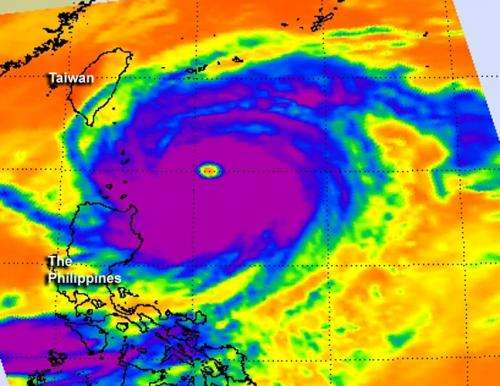NASA sees a wide-eyed Super Typhoon Jelawat

One day ago, Super Typhoon Jelawat's eye was about 25 nautical miles in diameter, today, Sept. 27, NASA satellite data indicated that eye has grown to 36 nautical miles!
The latest infrared image from the Atmospheric Infrared Sounder (AIRS) instrument that flies on NASA's Aqua satellite shows a clear eye in Typhoon Jelawat on Sept. 25. The cloud top temperatures of the thunderstorms surrounding the eye exceed -63 Fahrenheit (-52 Celsius) indicating that they are very powerful and heavy rainmakers.. Jelawat also has a rounded shape indicating that circulation is strong and symmetrical
On Sept. 25, Super Typhoon Jelawat's maximum sustained winds were near 95 knots (109 mph/176 kmh). It was located about 390 nautical miles (449 miles/722 km) south-southwest of Kadena Air Base, Okinawa, Japan, near 21.4 North and 124.0 East. Jelawat was moving north-northwest at 9 knots(10.3 mph/16.6 kmh) and generating extreme seas with wave heights to 48 feet (14.6 meters).
Like Ewiniar, Jelawat is also expected to affect Kadena Air Base and its center is forecast to move very close to the island. The Joint Typhoon Warning Center noted "Regardless of the exact track near Okinawa, Jelawat is a 300 nautical mile wide system with a large eye and eyewall and will maintain 100 plus knot winds (115 mph/185 kmh) through (48 hours from Sept. 27 at 11 a.m. EDT/1500 UTC) due to continued favorable environmental conditions."
Jelawat is then expected to continue north-northeast and make landfall just south of Kyoto, Japan on Sept. 30.
Provided by NASA's Goddard Space Flight Center




















